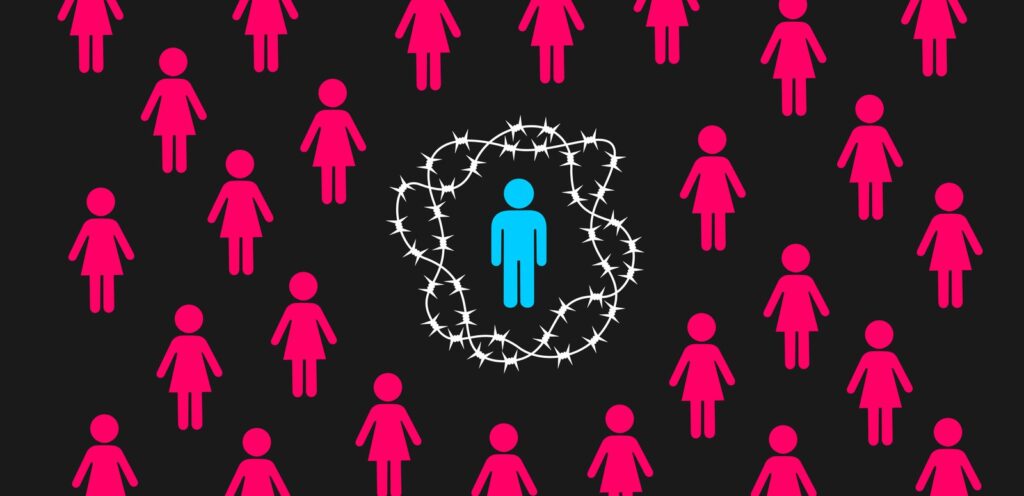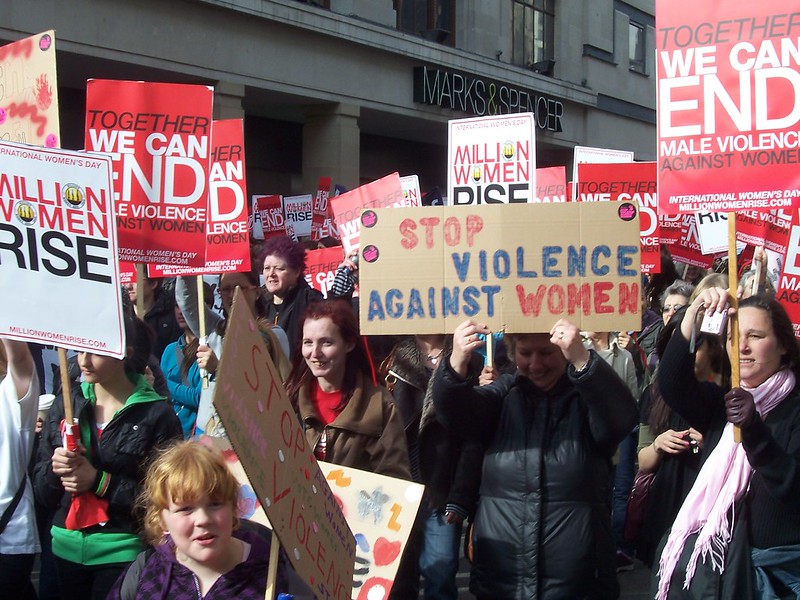How should we be responding to the threat posed by misogynist ideology and violence?

This piece was originally published by New America. It is reposted here with permission.
On March 3, in a speech streamed via YouTube to over 6,000 viewers, a Canadian judge found the perpetrator of the Toronto van attack—which killed 10 people and injured 16 more—criminally responsible. This verdict, combined with the devastating murder of eight people in the Atlanta area (six of them Asian women), has once again increased media attention to misogynist violence. Yet much of this attention continues to demonstrate an aversion to naming misogyny and racism as such.
Coverage of the incel community has been rife with misunderstandings, beginning with the inaccurate association of all self-identified incel (“involuntarily celibate”) people with the more recent formation of an online movement of misogynist incel men, rooted in the manifesto of the perpetrator of an attack in Santa Barbara in 2014.
In a report published February 18th by the Institute for Research on Male Supremacism (IRMS) and New America, we explain that this “misogynist incel” mobilization shaped around dehumanization of women, men’s entitlement and idolization of prior mass killers must be distinguished from supportive communities for men and women who lack desired sexual and romantic relationships.
In handing down her verdict, Justice Anne Molloy from the Ontario Superior Court of Justice chose to refer to the perpetrator as “John Doe.” She asked others to follow suit and refuse to provide mass killers with the notoriety they desire—which aligns with the mission of the No Notoriety campaign and is incorporated into the IRMS recommendations for media.
Beyond this caution for media, we make five key recommendations for dealing with misogynist incel violence and other forms of male supremacism—informed by an understanding of this as a structural problem that is part of a spectrum with more “everyday” misogyny and sexism.
1. Fund more research and collaborations into male supremacism broadly and protect researchers’ ability to work in the face of threats and doxing.
While most recent misogynist mass violence has been connected to incel ideology, misogyny emerges as a driver of violence in other forms as well.
On March 16, a 21-year-old white man shot and killed eight people across three Atlanta-area massage parlors, six of the victims Asian women. Though some commentary labeled him an incel, no evidence has emerged yet of his connection to that ideology. Instead, the term “incel” is being used in place of “misogynist,” despite this attack appearing to be driven by a more mainstream anti-Asian racism and misogyny.
In another example, in 2020 a men’s rights lawyer who also frequented male separatist Men Going Their Own Way (MGTOW) forums targeted a federal judge, a Latina woman, killing her adult son. He had a list of other women judges on his intended hitlist. The fathers’ rights movement has a long history of global violence, including targeting judges and bombings, and the men’s rights movement has been at the forefront of harassment and doxing of women. Researching and understanding male supremacism broadly (not just misogynist incels), and its intersections with racism and other ideologies, is crucial to addressing future threats.
While tech solutions to misogyny, racism and other forms of hateful or dehumanizing speech have focused on deplatforming perpetrators, individuals doing research in this area, particularly women, require protections against harassment and doxing that often accompany this work. Both the risks of work on male supremacism and the strain of the dehumanizing subject matter itself impact the ability of researchers to do this work. Threats to personal security—and the safety of family—act as deterrents to doing public work in this area.
We recommend funders, including tech companies whose platforms facilitate harassment, set up a pool where any researcher working on misogynist mobilizations and other subjects with a high risk of doxing can apply to receive a grant for digital security services and training as part of protecting free speech. (The authors of this report thank the Urgent Action Fund for Women’s Rights for its grant-making toward digital security protections, which we have benefitted from.)
2. Support improved mental health services and access as a social good—but do not mistake this for a solution to ideological violence.

Suicide rates in the world and in the United States in particular have increased in the past 20 years, and loneliness has been declared a public health issue. Adequate universal mental health care access falls far short, and increased access to therapy and other services is a social good, including for self-identified incels—men, women and non-binary people—and any people dealing with depression, loneliness or other mental health issues.
However, we caution against approaching mental health issues as the main driver of misogynist violence, or therapeutic treatment as a solution. A 2020 counterterrorism journal article exemplifies the approach of recommending mental health services to prevent “incel violence,” stating, “Arguably, the most effective way to prevent an incel from ‘going ER’ [a term used in misogynist incel forums to encourage attacks like the one in Santa Barbara] is by proactively addressing his suicidal impulses.” This is a misplaced focus.
While many mass violence perpetrators intend to kill themselves or commit “suicide by cop” at the end of their attack, potentially to avoid imprisonment and establish themselves as martyrs for a cause, this is not always the case. Ideologically-motivated violence—including from misogynist incels—can occur without perpetrators committing self-harm. There are decades of such examples of white supremacist, anti-abortion, and other ideological violence.
The focus on mental health treats loneliness and depression as the root cause of incel violence, rather than misogyny and male entitlement. Yet for most populations, impulses toward self-harm do not manifest in a decision to kill others. Avoid reinforcing misogynist incel men’s sense of being the only people who truly experience suffering. Vulnerable populations at the highest risk for attempted suicide and depression, for instance, queer young people, do not perpetrate mass violence. Entitlement, superiority and a feeling of moral justification animate perpetrators of mass violence, who are most often cisgender, heterosexual, white men.
Though many misogynist incel men refuse therapy as an ineffective solution to what they view as systemic problems, others tried therapy but retained their misogynist ideology and returned to the online communities. The Santa Barbara perpetrator received extensive mental health support and therapy due to his parents, including meeting a weekly counselor in an informal social setting.
While there is space for mental health services to improve in terms of avoiding the reproduction of white male supremacy, mental health services are not designed to treat ideology, because misogyny, supremacism and other harmful ideologies are not mental health issues.
A misplaced focus on mental health issues as leading to violence can harm how people with depression or other psychological conditions are perceived; for instance, autism advocacy groups spoke out against blaming autism, as the defense for the Toronto van attacker attempted.
We support policies to increase the quality of and access to mental health services—including improvements in training regarding recognizing and addressing misogynist, dehumanizing, and abusive belief systems—with input from mental health advocacy groups, especially those led by the communities they serve, without focusing on this as a solution to misogynist violence.
3. Interventions should draw on examples from specialized counseling programs designed to deal with domestic abuse perpetrators and counter racist violence.
Recommendations for dealing with potential incel violence have suggested helping these men form “intimate relationships” with women, with the expectation that this will mitigate their “desire for dominance.”
Yet misogynist incel men have asserted that violence against women partners for failing to meet their sexual or other expectations would be justified, and despite their anger over not having partners, their worldview demonstrates similarities with that of intimate partner abuse perpetrators. Domestic abuse perpetrators feel entitled, wronged as victims when they do not get what they want, and justified in committing violence in response. Shifting the sphere of potential violence from the public sphere to private is not a successful intervention.
Misogynist mass violence exists on a continuum alongside other gender-based harassment and violence, including intimate partner abuse, stalking, rape, and murder. Perpetrators of mass violence acting from any ideological motivation are virtually always men and tend to have in common histories of abuse or harassment of women. Women in abusive relationships face the greatest danger of being killed when they attempt to leave men who feel entitled to possess them. Helping misogynist men form relationships is not a panacea for desire for dominance, but it can endanger their potential partners if pursued without addressing their underlying misogynist beliefs.
We recommend programming to address misogynist incel men that learns not only from existing deradicalization programs aimed at “extremist” ideologies, which have benefits and flaws, but also from feminist-informed domestic abuse perpetrator intervention programs. These programs confront beliefs such as male entitlement, strict gender roles, and ownership of women; they recognize that mental health issues can exist concurrently with but are separate from abusive behavior, and require appropriate approaches to address each without conflating them.
4. Avoid interventions that reinforce boys’ and men’s entitlement—and prioritize collaborations with gender justice organizations that can strengthen program design.
A video created for a proposed youth intervention to prevent misogynist incel violence shows how well-meaning approaches can reinforce boys’ and men’s entitlement. The video depicts a scenario in which a boy texts a girl asking her out, is declined, and then insults her. The second scenario shows what the program teaches should be done: The boy wishes the girl well, asks out someone else, and she accepts. This establishes a narrative of an expected reward structure: the reason for basic decency is not based on empathy or humanization but to gain access to girls/women.
When that does not happen in real life—when the next girl exercising her agency also decides to say no—boys and men feel unjustly deprived of a reward to which they felt entitled by following the script. Not receiving the expected outcome (access to women) from utilizing techniques to get women’s attention, as with men who attempted technique to learn “game,” has further reinforced and radicalized misogynist incel men’s beliefs.
Given that misogynist violence has only recently been recognized in the countering violent extremism (CVE) and counterterrorism fields, organizations often lack experts who are versed in issues like violence against women, male supremacy and misogyny—gaps reflected in their analyses and recommendations. We need support collaborative projects that bring into coalition organizations embedded in feminist and gender justice frameworks, to avoid inadvertently supporting boys’ and men’s entitlement and other errors that reinforce male supremacism.
5. Intervene early and through routine systems to prevent movement along a spectrum of dehumanization and misogyny toward violent extremes.
Misogynist incel ideology and other extreme male supremacist ideologies exist on a continuum, developing from mainstream structures of male supremacy, entitlement, and objectification of women.
In a 2020 political science journal article, Sian Tomkinson, Taeul Harper and Katie Attwell emphasize routine systems of intervention and suggest that “education of community workers, police, politicians and teachers to engage with misogyny’s threat to public security would simultaneously solve some of the pitfalls of contemporary responses to gender-based violence more broadly.”
Given that participants in misogynist forums often join beginning in their teens, effective prevention necessitates interventions starting in childhood to address the roots of misogyny. Comprehensive sexual education can deliver vital consent-based content, but in the United States has been targeted by the Christian Right and replaced in many locales with abstinence-only education that teaches gender stereotypes and victim-blaming.
Many books in the standard U.S. English literary curriculum perpetuate male entitlement and sympathize with male sexual frustration, ignore consent and present women as dehumanized props or fantasies. Updating curricula by drawing on a feminist and antiracist perspective to reflect a diversity of characters and authors—humanizing women and other excluded populations—can work against deepening misogynist beliefs.
Much of CVE funding goes to deradicalization programs or short-term interventions for at-risk individuals at what might be considered the eleventh hour. We recommend longer-term creative thinking and prevention through structural change by supporting social justice organizations working on core issues such as sexuality education and education justice.
You may also like:





